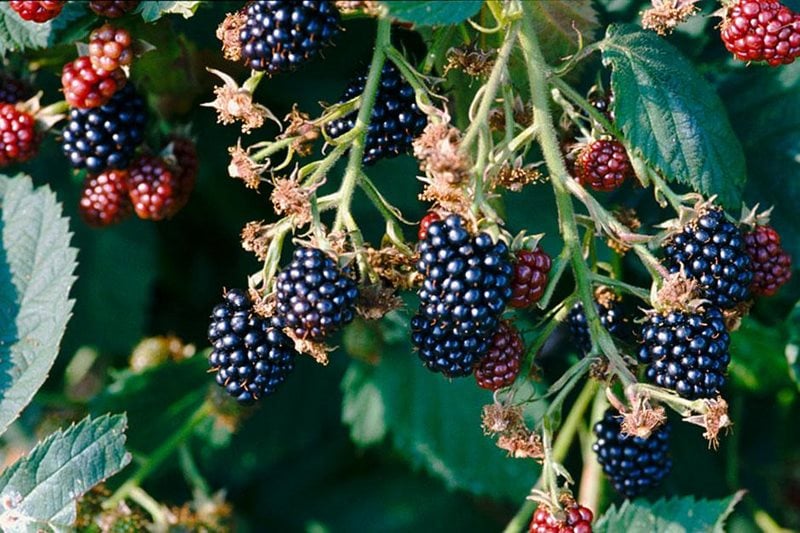
- Botanical name: Rubus fruticosus.
- Origins: Blackberries have been growing wild in Europe, Asia and the Americas for thousands of years.
- First cultivated: Judge Logan is credited with being the first person to breed blackberries in late nineteenth century America. He also developed the Loganberry, a blackberry and raspberry hybrid.
- Types: There are numerous modern cultivars available including upright varieties (such as 'Navaho'), trailing varieties (such as 'Black Cascade') and thornless varieties (such as 'Loch Ness').
- Skill level: Easy.
- Preferred location and conditions: Blackberries prefer moisture-retentive, free-draining soil in a sunny, sheltered site.
- Good for containers: Compact varieties are available for container-growing.
- Planting and growing: Plant from January to April. Ensure the site is well-prepared with plenty of well-rotted manure or compost. Container-grown plants should be spaced 2.5m-4.5m apart (depending on the cultivar), using supports if planting a vigorous variety. After planting, cut down all canes to a healthy bud to ensure strong growth in spring.
- Harvest time: July to September.
- Possible problems: Cover the plants with netting or fleece to protect them from hungry birds.
See RHS advice on growing blackberries
Did you know?
Forensic evidence suggests we’ve been eating blackberries for thousands of years, and nowhere are they more highly prized, than in Britain. Whether eaten straight from the plant, baked into cakes, stewed into jam or fermented as wine, blackberries offer a sweet and delicious taste of late summer.
A member of the rose family, the blackberry is not really a berry at all, in the botanical sense. It’s an aggregate accessory fruit, meaning that the flesh is not derived from the ovaries of the plant but from the receptacle that holds them.
The tradition of ‘blackberrying’, to scour the summer hedgerows to take advantage of the wild bounty on offer, is still a popular British pastime. During World War One, however, it was considered something of a necessity after food rationing was introduced. Schemes were established to make the most of the natural resources available, and English children were given time off school to pick blackberries for the production of juice and jam that were sent to soldiers fighting on the front line.
Sometimes referred to as ‘brambles’, blackberries are synonymous with Michaelmas, when the Archangel Michael defeated the angel Lucifer in battle, banishing him from heaven. So the story goes, Lucifer landed in hell, end-first in a thorny blackberry bush, and in his fury, he spat on the bush and cursed its fruit. Hence the lore that blackberries are unfit to eat if picked after Old Michaelmas Day (10th or 11th October). Whether you believe the story or not, there is some wisdom to leaving blackberries well alone once summer has passed, as the cold, wet weather of autumn encourages mould such as Botryotinia to infect the fruit.
In Celtic folklore, an arch of bramble which has rooted at both ends was believed to have special powers, from invoking evil spirits, to curing a child’s whooping cough. These days, however, blackberries are more commonly known to ward off coughs, colds and sore throats, thanks to their high vitamin C content, anti-inflammatory and anti-viral properties. Blackberry vinegar, made by steeping the fruit in vinegar for a few days, before boiling with honey and sugar, is an effective home remedy against the common cold.
Blackberries are also rich in antioxidants which can help prevent cancer and heart disease, and are packed with polyphenols, which are thought to enhance memory performance and improve cognitive function.
Cultivated blackberries are more productive than their wild counterparts, and are easy to train up trellises or over arches. Even with limited space, there are compact varieties of blackberry available that will grow happily in containers, so there’s no reason not to seize the benefits of this most beloved of British fruit.
Text provided by Mr Fothergill's

